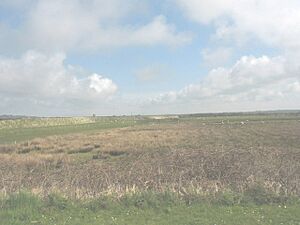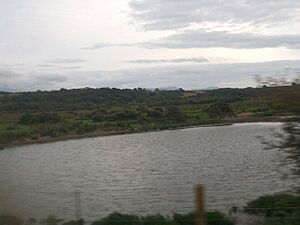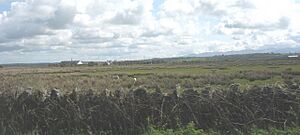Malltraeth Marsh facts for kids
Malltraeth Marsh, also known as Cors Malltraeth in Welsh, is a large marshy area in Anglesey, North Wales. It's located north-east of Malltraeth village. This marsh was once part of a tidal area, but it was changed into land after a long wall, called the Malltraeth Cob, was built in 1824. This wall helped control the water from the Afon Cefni river.
The name "Malltraeth" means "bad sandy shore." The marsh is huge, covering about 1,366 hectares (about 3,376 acres). It's so special that it's protected as a Site of Special Scientific Interest (SSSI). This means it's an important place for nature, with lots of different habitats like reedbeds, wet grasslands, and small lakes.
Contents
How Malltraeth Marsh Was Formed
Long ago, in the Middle Ages, the Malltraeth area was a wide estuary, meaning it was a river mouth where the tide came in. It stretched far inland, reaching places like Llangefni.
In 1790, a law was passed to build strong walls, called embankments, to protect the marsh from floods. This project helped turn about 1,600 hectares (4,000 acres) of wet, muddy land near the Afon Cefni into useful land. More improvements were made in the late 1700s and early 1800s to control flooding.
During World War I, farmers were worried about their crops, so more work was done to improve the marsh. However, after the war, the land wasn't looked after as well. There were many arguments about how to manage the marsh. In 1944, important people like Lord Anglesey met with government officials to plan improvements. A lot of money was spent to fix the marsh, which was about half ruined during the war. By 1947, over £147,000 had been spent on the project.
Where is Malltraeth Marsh?
Malltraeth Marsh is located in the area called cwmwd of Malltraeth. It's on the west side of the Afon Cefni valley, which runs across Anglesey. The marsh is about 6.5 kilometers (4 miles) north-west of the Menai Strait.
On the east side of the Afon Cefni, there's another wetland area called Cors Ddyga. This area has been turned back into wetlands and reedbeds. It's now a special nature reserve called RSPB Cors Ddyga. Both marshes have wet grasslands, lakes, and pools.
The ground under both Malltraeth Marsh and Cors Ddyga is made up of different types of rock, including Carboniferous Limestone, sandstone, and coal. The Afon Cefni valley is about 14.5 kilometers (9 miles) long and runs almost parallel to the Menai Strait.
Malltraeth Marsh is a wide, flat area of grassy land with reeds. A river, controlled by embankments, flows through the middle of it and opens up to Malltraeth Sands. There's also a short tunnel, the first in Anglesey, that goes through the low hills near the marsh.
Plants of Malltraeth Marsh
The plants found in Malltraeth Marsh and Cors Ddyga include reed canary-grass, water-plantain, branched bur-reed, club rush, and reed sweet-grass. You can also find Spiked water-milfoil, blunt-leaved pondweed, and horned pondweed in the marsh. Some rarer plants like flowering rush, water-violet, and marsh stitchwort also grow here.
Animals of Malltraeth Marsh
European water voles live in the marsh. Many birds can be seen here, especially in the wet grasslands. These include northern lapwings, Eurasian curlews, common redshanks, and common snipes.
In the open water areas, you might spot Eurasian teals, northern shovellers, gadwalls, and common pochards. Other birds that have been seen are the Eurasian bittern and grey heron. The marsh is also home to different insects, such as water beetles and hairy dragonflies.
Protecting Malltraeth Marsh
Malltraeth Marsh and Cors Ddyga are both Sites of Special Scientific Interest (SSSI). These marshes are important because of the birds that breed there, their damp grasslands, and their reedbeds. The ditches and waterways are also very important for different plants. The Royal Society for the Protection of Birds (RSPB) has a nature reserve in the north-east part of the SSSI.
To protect the marsh, several things are done:
- Water Levels: They keep the water levels just right by looking after the clay-lined ditches. This helps protect the plants and animals.
- Swamp Areas: Special swamp areas are kept for birds like the bittern to breed.
- Shallow Ditches: Shallow ditches are created along old water paths. This helps drain large areas where wading birds can find food.
- Water Control: Structures are used to control water in smaller drains. This keeps the groundwater high in spring, which is good for the marsh.
- Controlling Invasive Plants: They work to stop harmful plants like fairy fern, Australian stonecrop, and Himalayan balsam from spreading.
- Protecting Birds: They try to reduce the number of predators like crows and minks by looking after hedges.
- Grazing: Animals are encouraged to graze in winter but less in summer. This helps create good nesting spots for ground-nesting birds.
- Farm Management: Farming is managed carefully to provide safe nesting places for wading birds.






